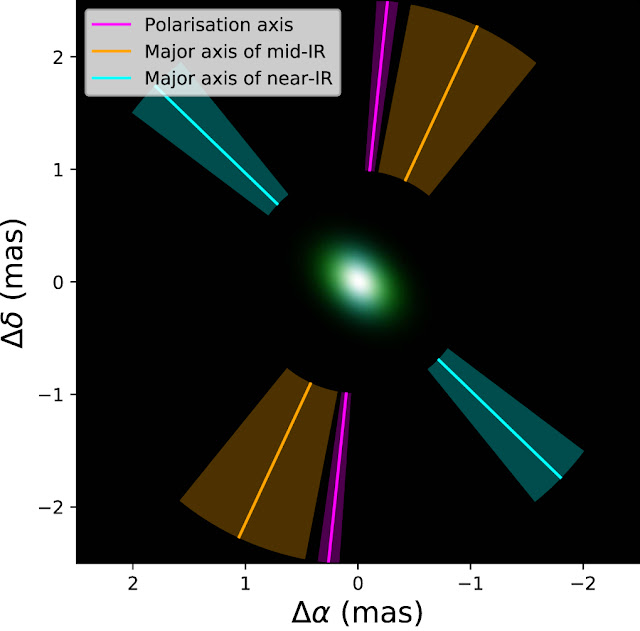Artist's illustration of the surroundings of a supermassive black hole at the heart of an active galaxy
Credit:ESO/M. Kornmesser
What’s going on deep in the centers of active galaxies, close around the supermassive black holes feeding off of their surroundings? A new study uses infrared observations to explore this inner region in one active galaxy.
The geometric dependence of AGN types in the unified AGN model. Type 1 AGN are viewed from an angle where the central engine is visible. In Type 2 AGN, a dusty torus obscures the central engine from view. Credit: Urry & Padovani, 1995
The geometric dependence of AGN types in the unified AGN model. Type 1 AGN are viewed from an angle where the central engine is visible. In Type 2 AGN, a dusty torus obscures the central engine from view. Credit: Urry & Padovani, 1995
A Unified Picture?
We know that active galactic nuclei (AGN) consist of a supermassive black hole accreting surrounding material and shining brightly across the electromagnetic spectrum. But the structure of the gas and dust close around the black hole, and the causes of the different emission we see, have remained a topic of debate.
Decades ago, scientists proposed that Type 1 and Type 2 AGN — two different categories of active galaxies with different observational properties — might be the same objects viewed from different angles. This unification scheme relies on the presence of a dusty torus — a puffed-up, donut-like dust structure close to the black hole. In this model, the torus obscures the inner, emission-line-producing gas from some viewing angles, changing the appearance of the AGN based on its orientation.
But recent infrared observations have challenged this view. With powerful mid-infrared telescopes, we’ve taken a closer look at the inner few hundred light-years of nearby active galaxies — and instead of revealing an obscuring torus of dust, these observations have shown polar dust structures.
Decades ago, scientists proposed that Type 1 and Type 2 AGN — two different categories of active galaxies with different observational properties — might be the same objects viewed from different angles. This unification scheme relies on the presence of a dusty torus — a puffed-up, donut-like dust structure close to the black hole. In this model, the torus obscures the inner, emission-line-producing gas from some viewing angles, changing the appearance of the AGN based on its orientation.
But recent infrared observations have challenged this view. With powerful mid-infrared telescopes, we’ve taken a closer look at the inner few hundred light-years of nearby active galaxies — and instead of revealing an obscuring torus of dust, these observations have shown polar dust structures.
A Search for Distant Dust
How can we explain these observations? Theorists have a solution: in the disk–wind model, the dust close to the black hole is arranged in a hot, equatorial disk rather than a torus. Radiation pressure then blows some of this dust off into a cooler wind from the poles, producing the polar structures we’ve seen in mid-infrared observations. Obscuration comes from the disk and the launch region of the wind.
The equatorial disk in this model should lie on scales too small to have been previously observed in mid-infrared — but there’s a new tool on the scene! GRAVITY, an interferometric instrument on the Very Large Telescope Interferometer in Chile, operates in the near-infrared. This makes it the perfect instrument to search for the very hot dust that would lie in a disk at the heart of an AGN.
In a new study led by James Leftley (University of Southampton, UK; Côte d’Azur University, France; ESO, Chile), a team of scientists has now used GRAVITY to obtain near-infrared observations of the center of ESO 323-G77, a local active galactic nucleus.
The Gaussian fits to the near-infrared emission show an elongated structure (center) oriented along the AGN’s equator. This is in contrast to the polar-aligned mid-infrared emission (orange region) that may represent a disk wind. Credit: Adapted from Leftley et al. 2021
The equatorial disk in this model should lie on scales too small to have been previously observed in mid-infrared — but there’s a new tool on the scene! GRAVITY, an interferometric instrument on the Very Large Telescope Interferometer in Chile, operates in the near-infrared. This makes it the perfect instrument to search for the very hot dust that would lie in a disk at the heart of an AGN.
In a new study led by James Leftley (University of Southampton, UK; Côte d’Azur University, France; ESO, Chile), a team of scientists has now used GRAVITY to obtain near-infrared observations of the center of ESO 323-G77, a local active galactic nucleus.
The Gaussian fits to the near-infrared emission show an elongated structure (center) oriented along the AGN’s equator. This is in contrast to the polar-aligned mid-infrared emission (orange region) that may represent a disk wind. Credit: Adapted from Leftley et al. 2021
Getting to the Heart of the Matter
Through careful analysis and modeling, Leftley and collaborators interpret their observations on scales of less than a light-year (for an object that’s hundreds of millions of light-years away!). The result? The near-infrared observations are consistent with an extended, equatorially aligned hot dust disk. The scale of this disk neatly matches the size predicted in disk–wind models.
Though the data are still too sparse and noisy to rule out the torus model in favor of the disk–wind model, these observations represent an important step in understanding how dust may be distributed in the heart of active galaxies.
Though the data are still too sparse and noisy to rule out the torus model in favor of the disk–wind model, these observations represent an important step in understanding how dust may be distributed in the heart of active galaxies.
Citation
“Resolving the Hot Dust Disk of ESO323-G77,” James H. Leftley et al 2021 ApJ 912 96 6.
doi:10.3847/1538-4357/abee80
By Susanna Kohler



